The Renaissance of the Russian White: A Cat Breed Revival
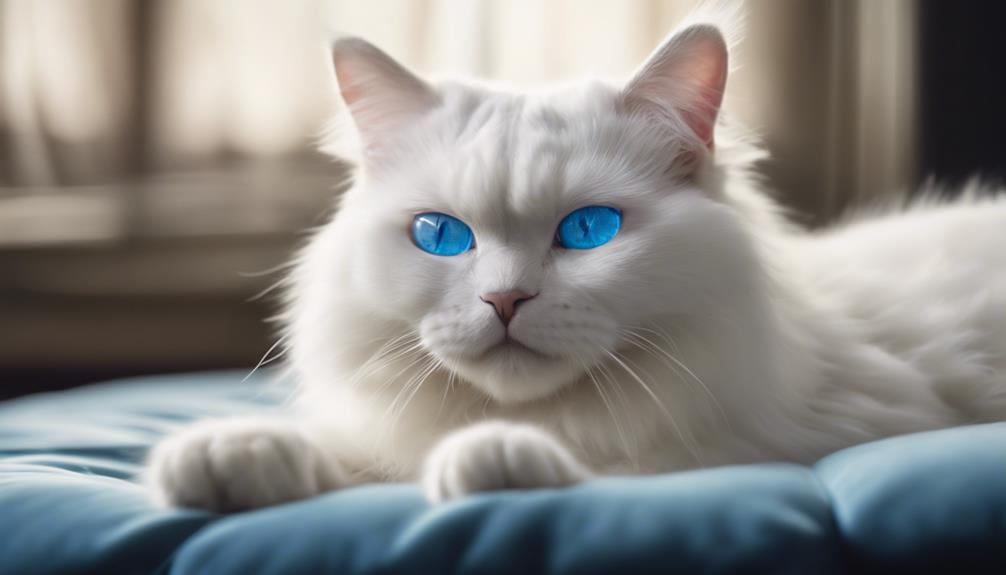
The Russian White cat breed is experiencing a resurgence in popularity. This revival sheds light on the breed's enduring allure and the efforts to preserve its legacy for future generations.
Sparkling interest in its unique traits and historical significance, this renewed attention highlights the Russian White cat's charm and importance in the world of cat breeds.
History of the Russian White Breed
Originating from Frances McLeod's breeding program in the 1960s, the history of the Russian White breed traces back to a deliberate and meticulous selection process for distinctive traits. Frances McLeod, a dedicated breeder, aimed to create a unique breed with specific characteristics, including the striking green eye color that's a hallmark of Russian Whites.
The breed gained recognition starting in 1971, first in Australia, New Zealand, and South Africa. Despite facing initial challenges in gaining widespread acceptance, the Russian White breed has made significant strides, with official recognition by the American Cat Fanciers Association in 2010.
Notably, Russian Whites are known for their flat nose, long head profile, and thick fur, particularly on their tails. Breed standards for Russian Whites emphasize the importance of maintaining the vivid green eye color that sets them apart.
This breed's history is a testament to the dedication and vision of breeders like Frances McLeod in creating a distinct and captivating feline breed.
Breeding Efforts and Conservation Success
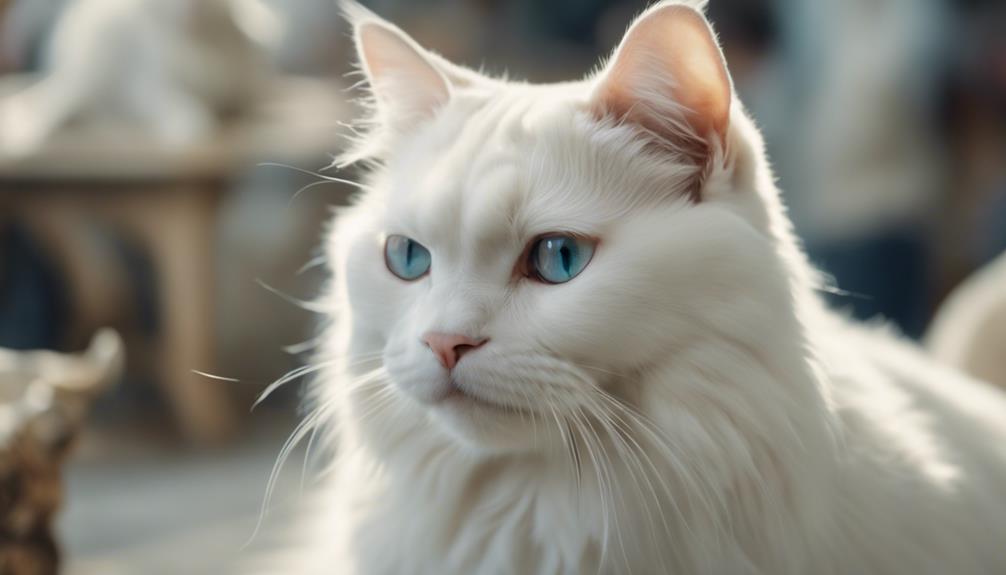
Breeding programs aimed at the Russian White cat breed have had a significant impact on the preservation of genetic diversity within the population.
By implementing responsible breeding practices, conservation efforts have successfully contributed to the revival of this breed.
The recognition of the Russian White cat by various breed registries worldwide underscores the positive outcomes of these dedicated conservation endeavors.
Breeding Programs Impact
The impact of meticulous breeding programs initiated in the 1960s by Frances McLeod is unmistakably evident in the successful restoration and recognition of the Russian White cat breed worldwide. Through these breeding efforts, the Russian White cat breed has experienced a remarkable conservation success, leading to its acknowledgment by various cat associations globally.
The careful selection processes implemented in the breeding program haven't only revived the breed but also contributed significantly to its preservation. This focused approach has resulted in the increasing popularity and acceptance of Russian White cats within the feline community. The recognition by cat associations is a testament to the effectiveness of the breeding programs in reviving and establishing the Russian White cat breed as a distinct and valued feline variety.
Genetic Diversity Preservation
Preserving the genetic diversity of Russian White cats has been a paramount focus of the meticulous breeding efforts aimed at the conservation success of this distinct feline breed. Through strategic breeding programs, breeders have worked to maintain a healthy gene pool, ensuring the longevity and vitality of the Russian White cat breed.
Genetic studies play a crucial role in identifying and preserving unique traits, contributing to the revival of this once-endangered breed. Collaborative efforts among breeders, veterinarians, and cat associations have been instrumental in safeguarding the genetic diversity of Russian Whites.
Unique Features and Characteristics
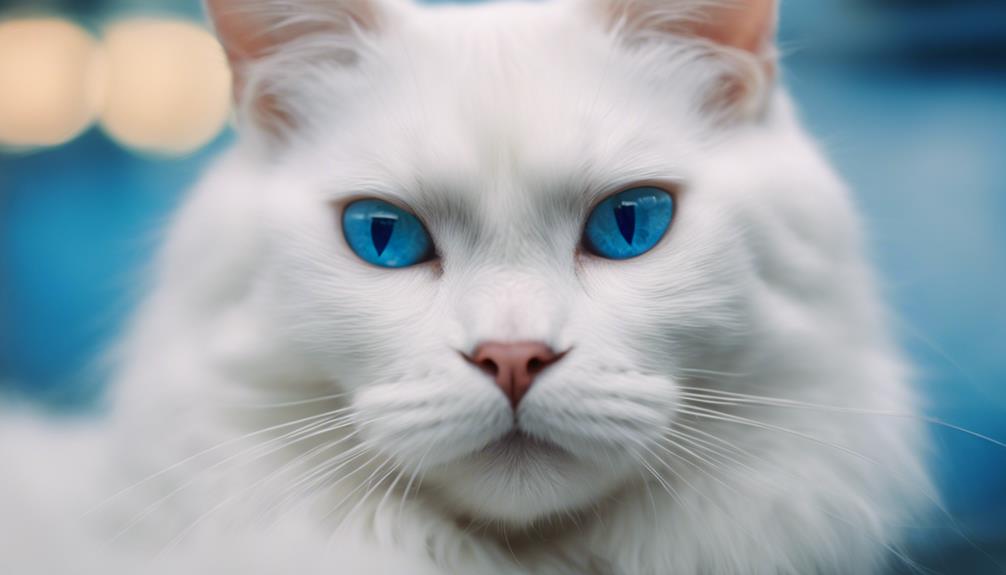
Russian White cats possess distinct coat colors, with the breed being known for their vivid green eyes, flat nose, and long, flat head profile. Despite their rarity and limited recognition by major cat associations, these cats are characterized by their affectionate and playful nature.
Breed standards stress the importance of achieving vivid green eyes with a green ring around the pupil by four months of age, distinguishing Russian Whites from other feline breeds.
Distinct Coat Colors
With a pristine and elegant appearance, Russian White cats are distinguished by their solid white coat color. The coat color of Russian White cats is a defining feature that sets them apart from other breeds. This solid white coat is consistent from birth through adulthood, maintaining its purity and elegance. The regal look of Russian White cats is accentuated by their pristine white fur, which reflects light beautifully. Below is a table highlighting the distinct coat color of Russian White cats:
| Coat Color | Description |
|---|---|
| Solid White | Pure white without markings or patterns |
| Consistent | Maintains the same color throughout life |
| Associated | Symbolizes purity, grace, and elegance |
| Reflective | Enhances the cat's regal and majestic appearance |
| Elegant | Adds to the charm and appeal of the breed |
Playful and Affectionate
Known for their playful and affectionate demeanor, Russian White cats exhibit unique features and characteristics that set them apart from other breeds. These feline companions aren't only known for their striking green eyes but also for their exceptional loyalty, quick learning abilities, and moderate talkativeness. Here are some key aspects that make Russian Whites stand out:
- Playful Nature: Russian Whites are energetic and enjoy interactive play, making them ideal companions for families.
- Affectionate Disposition: These cats thrive on human interaction and are known for their loving and cuddly nature.
- Distinctive Green Eyes: Their vivid green eyes are a hallmark feature that adds to their charm and allure.
- Sociable and Loyal: Russian Whites form strong bonds with their owners and are known for their dog-like loyalty.
Popularity Surge Among Cat Enthusiasts
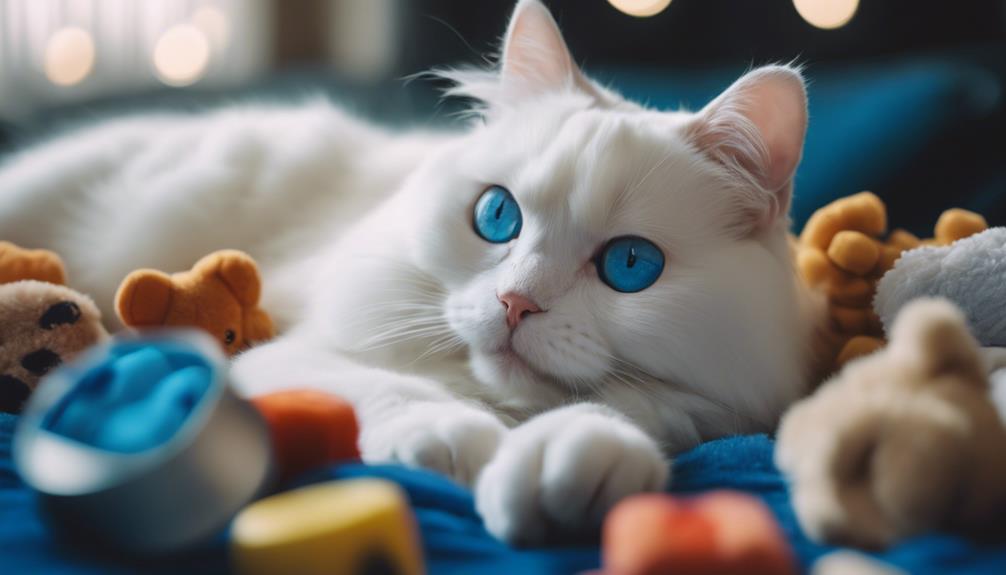
The surge in popularity among cat enthusiasts for the Russian White cat breed is evident in the increasing demand for these elegant felines. Russian White cats, being one of the prominent white cat breeds, have captured the hearts of many cat lovers and breeders due to their unique characteristics and graceful appearance.
This newfound interest in Russian White cats has sparked a revival in efforts to preserve and promote the breed on a global scale. The rise in social media usage has been instrumental in showcasing the beauty and charm of Russian White cats, further contributing to their growing popularity among cat enthusiasts.
Cat shows and exhibitions have also played a crucial role in highlighting Russian White cats, placing them in the spotlight and enhancing their visibility within the feline community. As the interest in Russian White cats continues to grow, their presence in various cat-related events is expected to further solidify their place as a beloved breed among cat enthusiasts worldwide.
Russian White's Personality and Temperament

Russian White cats exhibit a laid-back and calm demeanor, making them ideal companions for households seeking a relaxed pet. When it comes to their personality and temperament, Russian Whites possess unique traits that make them stand out among other cat breeds:
- Loyalty: Russian White cats show dog-like loyalty to their owners, forming strong bonds and displaying affectionate behavior towards them.
- Independence: Due to their independent nature, Russian Whites can be challenging to train, requiring patience and consistent positive reinforcement.
- Social Adaptability: While initially shy around new people, Russian White cats can become social and affectionate once they feel comfortable and secure in their environment.
- Rewarding Companionship: Their distinct personality traits make Russian White cats a fascinating and rewarding breed to own for cat enthusiasts seeking a loyal and loving companion.
Understanding these characteristics can help individuals appreciate the unique qualities that Russian White cats bring to households, making them cherished members of the family.
Health and Care Considerations
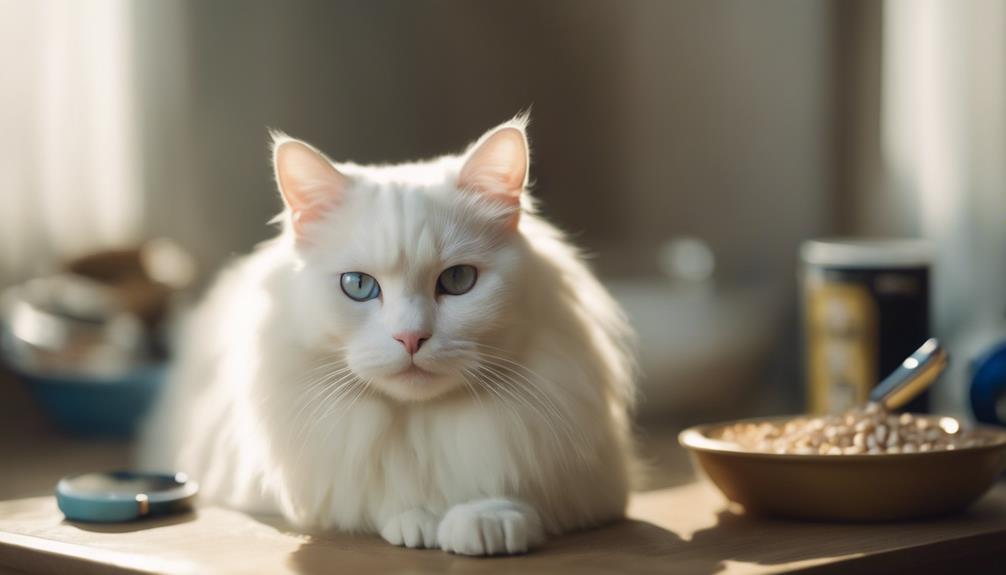
Transitioning from discussing the Russian White cat breed's personality and temperament, considerations for the health and care of this feline companion are crucial for maintaining their well-being. Russian White cats, known for their elegant white coat, may be predisposed to urinary tract problems, dental issues, and obesity.
To ensure their optimal health, regular veterinary check-ups are essential. Dental care is particularly important for Russian White cats, requiring toothbrushing or dental treats to prevent dental issues that can impact their overall well-being. Alongside dental care, maintaining a balanced diet is crucial to prevent obesity, a common concern for this breed.
Grooming routines for Russian White cats should include weekly brushing, nail trims, and toothbrushing to uphold their luxurious coat and overall health. Additionally, providing ample exercise opportunities such as toys, cat towers, window seats, and scratching posts is vital to prevent obesity and keep them mentally stimulated.
With a lifespan of around 10-15 years, caring for a Russian White cat necessitates a long-term commitment to their health and well-being.
Future Prospects and Trends

In the realm of feline breeding and genetics, emerging trends suggest a promising future for the Russian White cat breed.
- Increased Recognition: Breeders are actively working to raise awareness and obtain recognition for Russian White cats in various cat associations and registries, highlighting their unique characteristics and charm.
- Growing Demand: The rarity and distinctive appearance of Russian White cats are attracting more enthusiasts, leading to an increasing demand for these elegant felines.
- Preservation of Purity: Efforts are being made to maintain the breed's purity and genetic integrity through responsible breeding practices, ensuring the continuation of the Russian White cat's unique traits.
- Global Accessibility: Russian White cats are becoming more accessible to cat lovers worldwide, fostering a bright future for the breed as it gains popularity and recognition on an international scale.
Breeders' dedication to preserving the breed's rarity and promoting responsible breeding practices is paving the way for a flourishing future for Russian White cats.
Frequently Asked Questions
How Much Is a Russian White Cat Worth?
Russian White cats' worth varies based on factors like breeder reputation, genetic health, and breeding standards. Costs range from $600-$1,200, with show-quality cats fetching $2,000+. Adoption fees from shelters are more affordable, $50-$200.
How Long Do Russian White Cats Live For?
Russian White cats are known for their longevity, with an average lifespan of 10 to 15 years. Common health issues include dental problems. A balanced diet, regular exercise, and proper grooming can enhance their well-being and lifespan.
Are White Russian Cats Rare?
White Russian cats are rare due to specific breeding patterns and genetics that maintain their purity. Despite this rarity, they have historical significance and are gaining popularity. Their coat variations can come with health concerns. Adoption trends reflect their gentle temperament.
What Is the Rarest White Cat in the World?
The rarest white cat breed globally emerges from meticulous breeding programs. A genetic mutation birthed this gem, captivating exotic pet enthusiasts. Its scarcity and distinct features make it a coveted feline treasure in the world.











